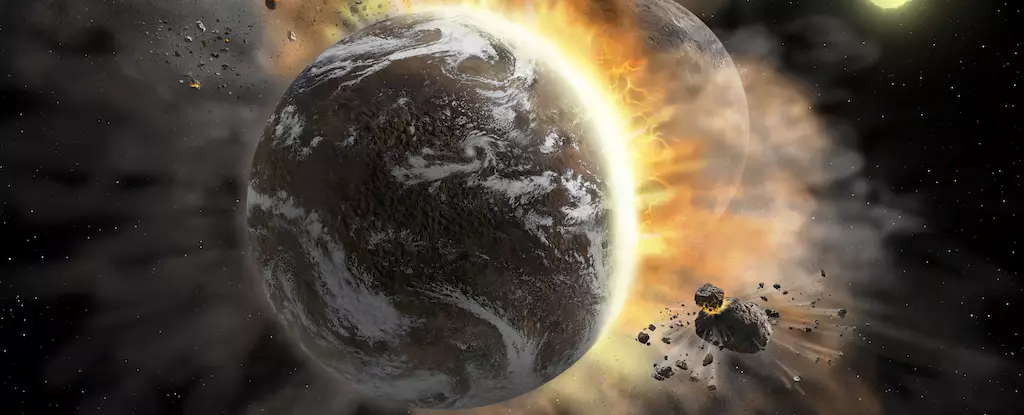The scars on the Moon’s surface tell tales of a tumultuous past. Each crater is a signature of intense collisions that shaped not only our satellite but also the early Solar System. What if our own Solar System’s inception was not an isolated event? The prevailing theory suggests that young solar systems across the universe experienced similar chaotic environments, rife with debris and impact. Researchers at UC Berkeley are delving deeper into this concept, simulating colossal planet collisions to unlock secrets about their formation and evolution that could reshape our understanding of planetary systems.
In a rapidly changing astronomical landscape, a recent study led by theoretical physicist J.J. Zanazzi has catalyzed intrigue. The paper, “Seismic Oscillations Excited by Giant Impacts in Directly-Imaged Giant Planets,” explores the seismic ramifications of colossal collisions between gas giants. Specifically, researchers focused on whether these impacts generate seismic waves—deep vibrations that may persist long enough to be detected by powerful telescopes such as the James Webb Space Telescope (JWST). By analyzing these factors, the researchers aim to shed light on the massive worlds beyond our orbit and what they may harbor beneath their colorful atmospheres.
Hunting for Seismic Signs Among the Stars
The fundamental questions guiding this investigation are pivotal: Can the seismic waves produced by a massive celestial collision be enduring, and, importantly, can we detect them? The JWST, with its remarkable photometric capabilities, cannot directly measure these waves; however, it can identify subtle alterations in light, which could serve as indirect evidence of seismic activity. “In principle,” the authors assert, these planet-scale impacts have the potential to stimulate seismic oscillations detectable by space-based missions like JWST and Roman.
Zeroing in on the exoplanet Beta Pictoris b, the researchers have targeted a young super-Jupiter approximately 12 to 20 million years old, weighing in at a formidable 13 Jupiter masses. This intriguing celestial body possesses an unusual abundance of heavy metals, suggesting that it has encountered significant collisions throughout its formative years, further enriching its metallic core. Such a volatility of elemental composition opens a window into the processes governing planetary development.
Creating Vibrations: The Mechanics Behind the Impact
To better understand the dynamics at play, the authors modeled an impact scenario involving Beta Pictoris b and a Neptune-mass planet approximately 17 Earth masses heavy. The study uncovers a striking conclusion: the accumulation of heavy metals in massive exoplanets is substantially influenced by these giant impacts. The excitement generated by such collisions transcends simple physical interaction, producing a spectrum of seismic modes that reverberate throughout the planetary body.
Once stimulated, these seismic activities may linger for durations analogous to the age of the young planet itself. The researchers predict observable luminosity variations of Beta Pictoris b linked to this seismic movement, thereby establishing a potential pathway for the JWST to detect these occurrences. A collision within the past 9 to 18 million years could lay bare some of these impressive signatures.
Seismology: The New Frontier of Exoplanet Exploration
The mapping of seismic waves offers a groundbreaking opportunity to delve into the inherently hidden structures of gas giants. “Seismology offers a direct window into giant planet interiors,” the researchers note, hinting at the potential for seismic frequency measurements to determine a planet’s bulk density—information that can deepen our understanding of exoplanet composition. This method could complement traditional gravity measurements, which have provided insights into the structures of planetary bodies that are farther away and revolving around distant stars.
The implications of this research extend beyond the mundane understanding of singular planetary bodies; they allow astronomers to investigate planetary migrations and the intricate processes that shape these celestial entities. Notably, other methods of exciting oscillations, such as eccentric migration due to tidal interactions with host stars, also warrant attention. Like the cosmic symphony of vibrations generated by planetary collisions, the detectability of oscillations from these migrations could unveil the complexities of exoplanet evolution.
The Promise of New Discoveries
By layering traditional astrophysical techniques with innovative seismic inquiries, the astronomical community stands on the precipice of a new era in exploring our universe. The study of seismic waves offers a promising toolkit to decode the histories of exoplanets, opening avenues for detection and analysis previously thought unimaginable. As researchers glean insights from Betas Pictoris b and beyond, we inch closer to comprehensively understanding not just how planets form, but also the narratives of the cosmic battles that precede their existence. Understanding these foundational moments could redefine our perceptions of planetary characteristics and life itself in the cosmos—a truly exciting frontier in astronomical research.

